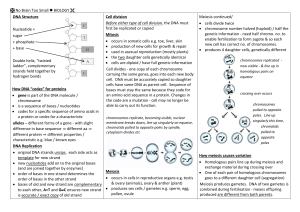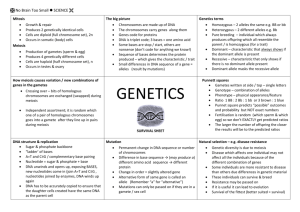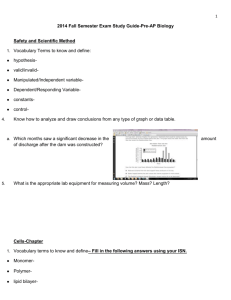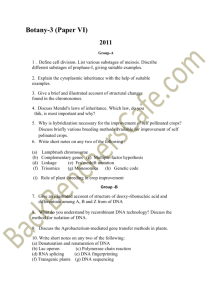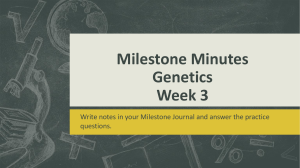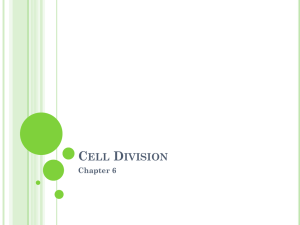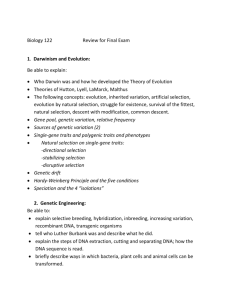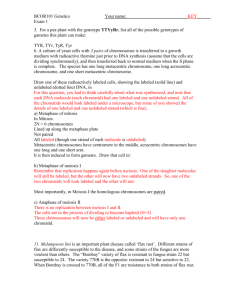Describe the transfer of genetic information DNA Structure
advertisement
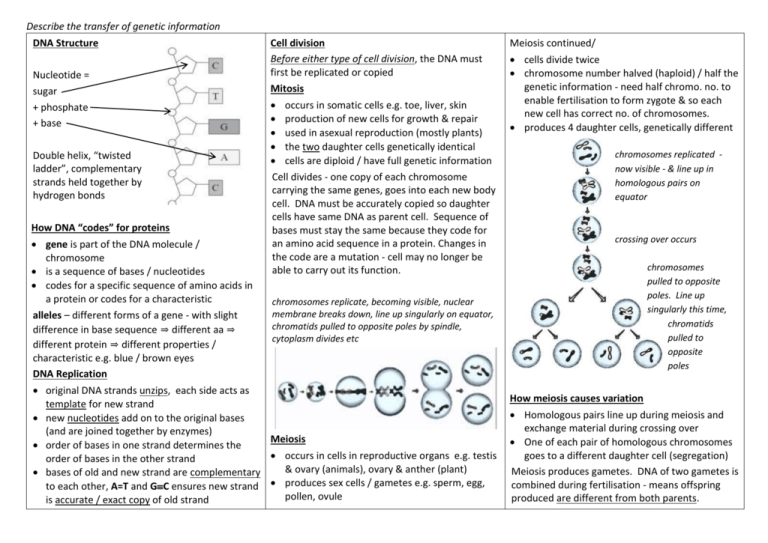
Describe the transfer of genetic information DNA Structure Nucleotide = sugar + phosphate + base Double helix, “twisted ladder”, complementary strands held together by hydrogen bonds How DNA “codes” for proteins gene is part of the DNA molecule / chromosome is a sequence of bases / nucleotides codes for a specific sequence of amino acids in a protein or codes for a characteristic alleles – different forms of a gene - with slight difference in base sequence ⇒ different aa ⇒ different protein ⇒ different properties / characteristic e.g. blue / brown eyes DNA Replication Cell division Before either type of cell division, the DNA must first be replicated or copied Mitosis occurs in somatic cells e.g. toe, liver, skin production of new cells for growth & repair used in asexual reproduction (mostly plants) the two daughter cells genetically identical cells are diploid / have full genetic information Cell divides - one copy of each chromosome carrying the same genes, goes into each new body cell. DNA must be accurately copied so daughter cells have same DNA as parent cell. Sequence of bases must stay the same because they code for an amino acid sequence in a protein. Changes in the code are a mutation - cell may no longer be able to carry out its function. Meiosis continued/ cells divide twice chromosome number halved (haploid) / half the genetic information - need half chromo. no. to enable fertilisation to form zygote & so each new cell has correct no. of chromosomes. produces 4 daughter cells, genetically different chromosomes replicated now visible - & line up in homologous pairs on equator crossing over occurs chromosomes pulled to opposite poles. Line up singularly this time, chromatids pulled to opposite poles chromosomes replicate, becoming visible, nuclear membrane breaks down, line up singularly on equator, chromatids pulled to opposite poles by spindle, cytoplasm divides etc original DNA strands unzips, each side acts as template for new strand new nucleotides add on to the original bases (and are joined together by enzymes) Meiosis order of bases in one strand determines the occurs in cells in reproductive organs e.g. testis order of bases in the other strand & ovary (animals), ovary & anther (plant) bases of old and new strand are complementary to each other, A=T and GC ensures new strand produces sex cells / gametes e.g. sperm, egg, pollen, ovule is accurate / exact copy of old strand How meiosis causes variation Homologous pairs line up during meiosis and exchange material during crossing over One of each pair of homologous chromosomes goes to a different daughter cell (segregation) Meiosis produces gametes. DNA of two gametes is combined during fertilisation - means offspring produced are different from both parents. Describe the transfer of genetic information Sexual and asexual reproduction Sexual (plants & animals) meiosis and variation involves gametes produced by meiosis produces variation advantage of variation - provide offspring with greater chance of survival in successive generations in a changing environment “slow” as offspring have to grow and become sexually mature before breeding can occur Asexual (plants and cloned animals) mitosis and a lack of variation advantage - faster produces genetically identical plants / animals produces / grows plants very quickly / plants fruit sooner than from a plant grown from a seed - benefits the grower - always get desired phenotype of plant & produce more plants to make a bigger profit or more plants in a shorter time disadvantages – e.g. plants all genetically identical, so susceptible to same diseases. Less variation – may be less suited to future changes in environment. KEY WORDS - for this part of the standard allele, asexual, characteristic, chromosome, clone, complementary, diploid, fertilisation, gamete, gene, haploid, karyotype, meiosis, mitosis, replication, selective breeding semi-conservative, sexual, trait, variation, zygote Asexual reproduction in plants vegetative propagation & cloning in plants Asexual reproduction techniques include taking stem cuttings, splitting bulbs or tubers and tissue culture. Eg tissue culture: A single plant is divided into small clusters of cells and placed on tissue culture. The single plant can produce many identical plants. Sometimes the original plant has been genetically engineered for a required gene. Cloning - Animals enucleating - microinjection - surrogate mothers (SCNT) nucleus transplanted into an enucleated cell electrical current is passed through it so that the cell starts dividing - embryo transplanted into a surrogate mother expensive, low success rate, some problems (eg premature aging), ethics surrounding humans!! Selective breeding – plants / animals Breed together individuals that have desirable phenotypes / characteristics eg cows with more meat or better milk yields, or a eg potato with resistance to disease & potato with a firm texture. Artificial twinning Egg from a desirable cow is fertilised by the sperm from a desirable bull. Fertilised egg is allowed to divide several times. The undifferentiated ball of Slow process – occurs of numerous generations. At cells is then broken up. Each cell is then grown and each stage individuals are selected with the desired transplanted into surrogate cows. Advantage: best characteristics. characteristics of animals can be selected and new animals produced Cross pollinate potato plants. Seeds grown / geminated. Potatoes grown from these seeds that faster than traditional show both desired characteristics can then be methods. NOTE: reproduced asexually to (quickly) produce a crop. Calves are clones of Both selective breeding & cloning processes (see each other but not opposite) reduce genetic diversity of a breed by of the parents. eliminating certain genes / combinations of genes. Describe the transfer of genetic information
